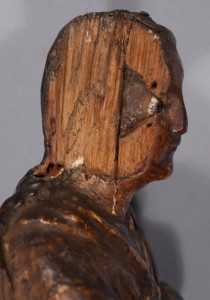
In Fall 2013, Art Properties began a program with the NYU Institute of Fine Arts Conservation Center to loan objects from Columbia’s art collection to the IFA CC so that students could benefit from object-centered learning. The IFA CC offers graduate degrees to students interested in the technical study and preservation of art and cultural heritage objects, such as paintings, sculpture in all media, and ceramics. Each semester one or more professors from the IFA CC have coordinated with the Curator of Art Properties to select works related to courses taught that semester. Examples to date have included the study and preservation of polychrome wood sculpture, as well as marble and bronze figurines.
This cooperative program has been mutually beneficial for both the IFA CC and Columbia. Students have the opportunity to work hands-on cleaning, stabilizing, and analyzing these objects, under the supervision of their Professor and in consultation with the Curator of Art Properties. Student conservation assessments, reports about each stage of their work, and technical photography are added to the Art Properties curatorial files so that future scholars can learn more about these objects in our collection. Below is one example of the work done by these students; future summaries will be posted over time to spread the word about this successful collaborative educational program. — Roberto C. Ferrari, Curator of Art Properties
Conservation Project & Report by Megan Randall, 2014
 The Virgin Mary of the Immaculate Conception
The Virgin Mary of the Immaculate Conception
Probably 18th century, Spanish Colonial Mexico or Mesoamerica
Wood with traces of polychromy and gold leaf, with glass eyes
H. 8 1/2 in. (21.6 cm)
Art Properties, Avery Architectural & Fine Arts Library
Columbia University in the City of New York
Gift of the Estate of Lola Szladits, 1990 (1990.8.25)
This treatment of the Spanish Colonial Virgin from the 18th century was completed as part of my training in the Polychrome Sculpture seminar with Professor Michele Marincola at the Institute of Fine Arts Conservation Center of New York University. I received the small statuette without any knowledge of its specific historical context or materials. As a result, the amount of information I gained in the examination and technical analysis of the object was significant. Although there are many interesting details of the treatment, research, and analysis of the statuette, this summary will deal with only one aspect of the treatment: the reversal and rejoining of the old repairs in the face of the figure.
Previous repairs to the face were failing. Small flakes of adhesive were loose in the join and the proper right segment of the face was visibly misaligned. In order to restore physical and visual integrity to the work, the adhesive in the join was reversed with ethanol and water and the old adhesive and insect residue on the surfaces were cleaned and slightly contoured to their proper alignment. The reversal of the old join revealed three things: the extent of the (dormant) insect activity in the form of worm holes and larva; the manufacturing method of securing the glass eyes in a ball of resin within a carved socket; and that the join consisted of three pieces instead of the previously-believed one piece.
 The procedure of reversing the join, cleaning surfaces, and shaping the dry-fit of the three pieces into their proper alignment were completed with time, consideration, and significant restraint in order to achieve the best possible results. The rejoining of the pieces back onto the statuette also had to be done quickly to ensure the adhesive was still tacky. The process was a quick and efficient race of warming the surfaces, adhesive application, and clamping the join. Because this task would only take a minute or less to complete, it was necessary to practice ahead of time the order of the pieces to be adhered and the placement of the clamps so that any kinks in the process were considered and resolved prior to the treatment.
The procedure of reversing the join, cleaning surfaces, and shaping the dry-fit of the three pieces into their proper alignment were completed with time, consideration, and significant restraint in order to achieve the best possible results. The rejoining of the pieces back onto the statuette also had to be done quickly to ensure the adhesive was still tacky. The process was a quick and efficient race of warming the surfaces, adhesive application, and clamping the join. Because this task would only take a minute or less to complete, it was necessary to practice ahead of time the order of the pieces to be adhered and the placement of the clamps so that any kinks in the process were considered and resolved prior to the treatment.
The surfaces were slightly heated with a radiant heat tool to encourage the affinity of the surfaces to the also-warm adhesive. Next, the warm adhesive, a 30% hide glue in distilled water, was applied to the surfaces with a brush, and the pieces were re-adhered to the statuette. Pressure was applied to the joins by using small clamps to ensure that the surfaces were properly connected. The clamps were left in place for 24 hours, then removed and inspected. The success of this phase of the treatment was thrilling. The treatment achieved the goals of restoring physical and visual integrity to the statuette and provided an ideal educational scenario to employ future treatment methods.